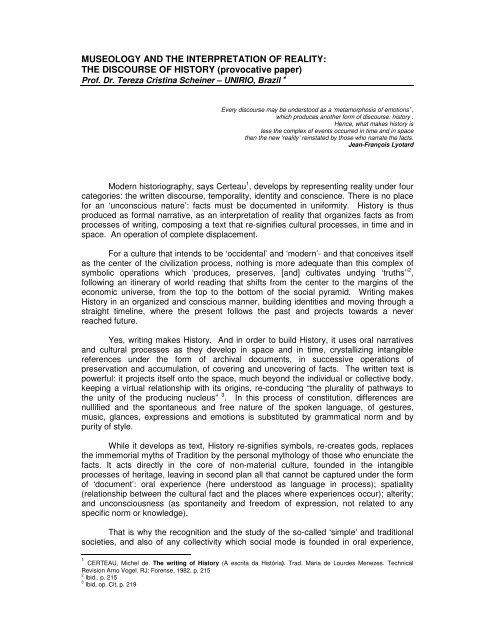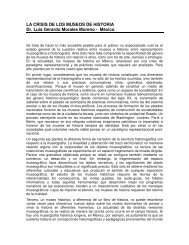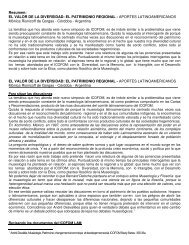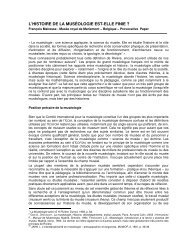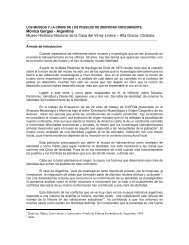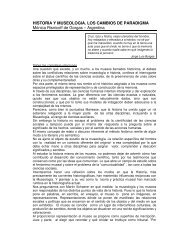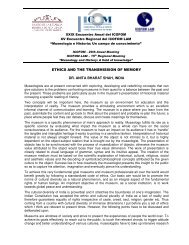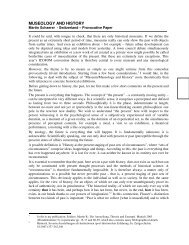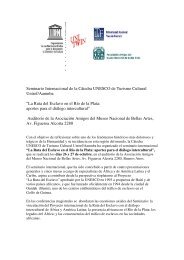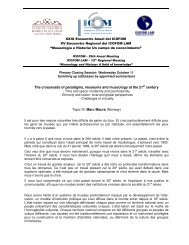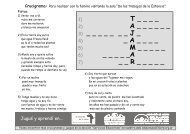MUSEOLOGY AND THE INTERPRETATION OF REALITY: THE ...
MUSEOLOGY AND THE INTERPRETATION OF REALITY: THE ...
MUSEOLOGY AND THE INTERPRETATION OF REALITY: THE ...
- No tags were found...
Create successful ePaper yourself
Turn your PDF publications into a flip-book with our unique Google optimized e-Paper software.
<strong>MUSEOLOGY</strong> <strong>AND</strong> <strong>THE</strong> <strong>INTERPRETATION</strong> <strong>OF</strong> <strong>REALITY</strong>:<strong>THE</strong> DISCOURSE <strong>OF</strong> HISTORY (provocative paper)Prof. Dr. Tereza Cristina Scheiner – UNIRIO, Brazil ∗Every discourse may be understood as a ‘metamorphosis of emotions’’,which produces another form of discourse: history .Hence, what makes history isless the complex of events occurred in time and in spacethen the new ‘reality’ reinstated by those who narrate the facts.Jean-François LyotardModern historiography, says Certeau 1 , develops by representing reality under fourcategories: the written discourse, temporality, identity and conscience. There is no placefor an ‘unconscious nature’: facts must be documented in uniformity. History is thusproduced as formal narrative, as an interpretation of reality that organizes facts as fromprocesses of writing, composing a text that re-signifies cultural processes, in time and inspace. An operation of complete displacement.For a culture that intends to be ‘occidental’ and ‘modern’- and that conceives itselfas the center of the civilization process, nothing is more adequate than this complex ofsymbolic operations which ‘produces, preserves, [and] cultivates undying ‘truths’’ 2 ,following an itinerary of world reading that shifts from the center to the margins of theeconomic universe, from the top to the bottom of the social pyramid. Writing makesHistory in an organized and conscious manner, building identities and moving through astraight timeline, where the present follows the past and projects towards a neverreached future.Yes, writing makes History. And in order to build History, it uses oral narrativesand cultural processes as they develop in space and in time, crystallizing intangiblereferences under the form of archival documents, in successive operations ofpreservation and accumulation, of covering and uncovering of facts. The written text ispowerful: it projects itself onto the space, much beyond the individual or collective body,keeping a virtual relationship with its origins, re-conducing “the plurality of pathways tothe unity of the producing nucleus” 3 . In this process of constitution, differences arenullified and the spontaneous and free nature of the spoken language, of gestures,music, glances, expressions and emotions is substituted by grammatical norm and bypurity of style.While it develops as text, History re-signifies symbols, re-creates gods, replacesthe immemorial myths of Tradition by the personal mythology of those who enunciate thefacts. It acts directly in the core of non-material culture, founded in the intangibleprocesses of heritage, leaving in second plan all that cannot be captured under the formof ‘document’: oral experience (here understood as language in process); spatiality(relationship between the cultural fact and the places where experiences occur); alterity;and unconsciousness (as spontaneity and freedom of expression, not related to anyspecific norm or knowledge).That is why the recognition and the study of the so-called ‘simple’ and traditionalsocieties, and also of any collectivity which social mode is founded in oral experience,1 CERTEAU, Michel de. The writing of History (A escrita da História). Trad. Maria de Lourdes Menezes. TechnicalRevision Arno Vogel. RJ: Forense, 1982. p. 2152 Ibid., p. 2153 Ibid, op. Cit, p. 219
have remained, for centuries, as an attribute of Anthropology and Ethnography – asituation that gained legitimacy based in a scientific status defined around the 17thcentury.That is why the Museum – this enunciator of culture and of the human experience– was strengthened as hegemonic experience throughout the same century, through oneof its representations: the traditional museum, space of shelter of documents consideredculturally relevant by those who, from the center, built the narratives of History. It was notby chance that the ‘museological’ discourse of Modernity has developed based in thosenarratives; and that, to do so, it has made wide use of Chronology, Paleography,Diplomatic – fields of knowledge recognized, up to a recent past, as ‘auxiliary sciences ofHistory’. Even ethnographic museums, essentially devoted to the study of the ‘simple’societies and of illiterate groups, have been mostly founded in the chronologicapproaches and narratives of historiography, making the discourse of the Different asfrom a center-based perception. In such museums, the writings about oral societies haveturned people into objects – and cultural facts into narratives of the ‘exotic’.A similar movement has permeated Natural History museums, where nature hasbeen approached as the main character of a grandiose script, referring to the evolution oflife in the planet. Built with the purpose of enunciating a ‘history of nature’, suchmuseums articulate narratives according to which life evolves in space, under a temporal,chronologic, linear perspective. This movement enables all kinds of tendentiousinterpretations: the images of a ‘savage world’, of ‘primitive societies’, of the ‘AmazonHylea’ and of ‘ferocious animals’ are part of this context, just to mention some of theterms and concepts which have characterized such narratives. Under the assertion ofretaining things in their ‘purity’, the trajectory of life in the planet, mainly of human life, isre-created under a centralized perspective – using words ‘as the body that signifies’ 4 , asthat which gives a true meaning to reality.We understand, though, that the relationship between Museology and History isnot simple at all – and that the analysis of the subject may be full of misunderstandings.This question does not exhaust with the approach of exhibitions in museums of History orwith the musealization of historic sites, even if those movements are part of a ‘quantum’related to the theme. The problem of the relationship between Museology and Historygoes deeper than that, and interferes directly in the ways and methods through whichboth History and Museology are conceived and developed.Among the many questions to be analyzed, the following categories may beconsidered as more relevant:1. MUSEUM <strong>AND</strong> LANGUAGEWe could also say Museum and World Narratives. Movements of convergenceand divergence may be identified here. Both the Museum and History are built throughdiscourse, approaching reality in a very specific way; both make use of a rational andtemporal conscience of the world, both articulate through reason, based in factualevidence. Yet museums are constituted simultaneously in spatiality andtemporality. And, even if for a long time they have only perceived or narrated the worldhistorically, the shift from modernity to contemporary status has enabled museums toarticulate their narratives as from new discursive frameworks.4 Ibid, in op. cit, p. 217.2
At present, it is not possible to disregard the mythical character which definescultures in their genesis and in their core, or the influence of myth in the constitution of avery rich symbolic universe that impregnates, in the most varied forms, the mechanismsof representation. Museums do not care so much in recreating the world starting from acenter or a pre-given idea: they now tend to present things in multiplicity, exposing themas they are - singular, fascinating fragments of reality. And each one of us must findwithin ourselves the meanings that can be assigned to them.To think History and Museum implies, thus, in trying to understand how thecircular (or cyclic) temporalities of Tradition articulate with the linear, focused temporalitywhich characterizes the ‘occidental’ (historic) mode of thinking reality; and also toperceive how evidences articulate, both among themselves and with the documentalfragments that signify them. It is imperative to think about the ways and forms throughwhich museums represent the synthesis of those tendencies, specially in what refers tothe narratives they elaborate.The emotional character of museological language must be also taken intoaccount: that which makes possible to impregnate, in every way, the senses of thereceiver - or even articulate, with passion, all the actors of the communicational process(a process that historiography relegates to a second plan). It is important to rememberthat both History and museums operate with re-readings of reality, through memory; andthat the different configurations of History, promoted by museums, depend of intrinsicrelationships that each museum establishes both with memory and with History, in eachtime and place. Such process develops through operations of presentation of the vestigesof facts and phenomena which remain in the memory, as elaborated by historicalnarrative.But the question does not wear out in the relationship between historiography andmuseography. It goes beyond: how is it that History represents museums? And howmuseums represent History? Which History they represent?1.1 – Memory, evocation, representationAlthough definitely social, the process of memory initiates as an individualprocess, directly related to self-perception and to the perception of the inner and outsideworlds to which each individual relates. This ‘private’ 5 memory is defined by means ofthe intertwining of voluntary and involuntary movements of perception, where past andpresent experiences are in close and permanent contact. Past is projected onto thepresent, by means of mental and sensorial representations, contributing for the shapingof ‘sceneries’ where the individual behaves as observer and/or acting character 6 . Thesum of the tangency nodes of such sceneries constitutes that which Halbwachsnominates as ‘social memory’- a process of articulation of remains that are common todetermined human groups, and that would be at the base of the movements thatconstitute group identities. About this process, Nora adds that what comes to us bymanipulation of remains is no longer memory, it is already history 7 ; we could thus saythat, although memory and history are not the same things, social memory is impregnatedwith historicism.But to sense the world in historicism does not signify to understand it only throughthe viewpoints of History, or to enunciate it through the discourse of History. Culture,says Sahlins, functions as a space of encounter, ‘a synthesis of stability and change, of5 (as studied by Freud, Bergson and Proust)6 See Erwin Goffman’s works7 NORA, Pierre, apud CERTEAU, Michel de. Op. Cit.3
past and present, of asynchrony and synchrony’ 8 . We are all fully immerse in thisdynamics of traits, experiences, remains and perceptions that constitute our beings andthrough which we shape our individual and social self, by means of mechanisms ofchange and of cultural reproduction. In such process, many times the incorporation ofthe new helps precisely to justify and reinforce values, concepts and world perceptionsthat are already established. But this does not signify the crystallization of the culturalprocess: all reproduction of culture implies an alteration.We must also remember that all conscious perception of reality has the characterof a recognition: instinctively, we relate the perceived objects with pre-existent conceptsand/or perceptions, in a continuous movement – as the Gestalt analyses have so wellexplained. The same occurs with the logical structure of discourse, where the specific isassimilated in the interior of a more general concept: ‘objective representation is not thestarting point in the process of language building, but the final point’ 9 . Language doesnot nominate, from the outside, objects that already exist – on the contrary, it mediatestheir shaping from inside out.We must thus analyze very closely the ways and forms by which such process isapprehended by museums. The appropriation of objects always depends on theeyes of the observer 10 , be this eye individual or collective; this process would be,therefore, always arbitrary and historic, related to pre-existent concepts, to specific waysof conceiving the world and engaging in it.This is the problem of language, and of interpretation: facts and phenomena arenot always perceived and explained in the same way, by observes who use differentsymbolic systems, even when they occur in the same time or space. This problemprojects into the sphere of museums. As all the acts of re-reading of reality, interpretationis built from the differential relationships existent in the interior of a given symbolic system(the cut in reality promoted by the interpretive movement); in museums, a new symboliccomplex is added to the complex already created by other languages - this hybridthat we call ‘museological language’.1.2 – Museum and the narratives of HistoryWe know that language cannot represent all the notions (ideas) that a referredobject awakens on the mind. This generates a disproportion between the word, the signand the referred thing: words will always say less than each thing signifies. But materialobjects (material things), when they make themselves present in the discourse, will unveilto the observer in their spectacular complexity, presenting, ‘under the form of experience,more properties and relations that could be chosen and valued by any other sign’ 11 . Anunquestionable advantage of museological language must thus be recognized, when it isbuilt over musealized material objects 12 : their symbolic force as elements ofpersonification of ideas.In the relationship between Museology and History, it must be taken into accountthe kind of relation that is being built, case by case. Museology develops a discourseabout History, and History has a discourse about museums. There is also a discourseabout History, elaborated by museums. This latter may be articulated, among otherforms, as academic language – and in that case, it will be defined and shaped by the8 SAHLINS, Marshall. Structure and History. (Estrutura e História). In: Islands of History (Ilhas de História). RJ: Zahar,1990 [1987]. p. 1809 CASSIRER, E. Apud SAHLINS, M. Op. Cit, p. 18310 Ibid., p. 18211 BRÉAL, J. Apud SAHLINS, M. p. 18512 We are here considering the expanded concept of object, which encompasses all the movable and inmovable referencesof material heritage.4
limits of written or oral language; but it may be frequently built as museological language,and represented, in most cases, under the form of exhibitions.In all those alternatives, it would be useful to analyze which perception of factsand actors of History museums allow, and which narratives they develop. In the presenttimes, many museums tend to project themselves beyond formal narratives, presentingan enacted re-creation of historic and/or natural facts, in spaces consecrated by theirpatrimonial (heritage) value. In such theatrical narratives, places and objects mayfunction as scenic spaces. In some cases, visitors are incorporated as actors, inexperiences that build a bridge between different spatialities, or between differenttemporalities, offering a fascinating sensation: that of being in the place of the Other,assuming, even for a short moment, another identity.2. MUSEUM <strong>AND</strong> IDENTITYTo offer to the visitor the experience of being the Other: that is a fascinatingexperience to museological narrative. We know that museums have always been relatedto the perception of identity (or identities, as we could now consider). And, althoughidentity may be conceived, in the theoretical sphere, as a permanent value, in practice itis always constituted in process, as the result of a permanent re-ordination of traits,multifaceted kaleidoscope of infinite – tangible and intangible – fragments of reality.How to approach the relationship between museums and identities? Although thetheme must be approached historically, we must also understand identity beyondhistory, looking for signs of its presence as mark of Tradition, form of art, poeticmovement or perceptual context. That is, trying to understand identity as a complex ofindividualities, where the id of each trait unveils, in all its significance.Contemporary society develops a strong, continuous public debate about thetheme of identity: it is treated in several fields of knowledge in an almost obsessive form –as if talking about an aspect of reality could guarantee, by proximity, its unveiling. Socioanalysisshows that such interest is related to the collapse of the ‘welfare State’ 13 and tothe emptiness of democratic institutions, consequential effects of a globalization processthat leaves us at drift, in a world where nothing more is secure, certain, or expected – andwhere the social links are re-shaped and re-signified, in continuous process. In suchenvironment, all that we aspire for is to return to the protected, familiar sphere of normsand traditions, that (we imagine) would save us from the uncertainties and theimponderable, offering a suitable alternative for the evils of a globalized world, whereeverything seems to be mediated by technique – from the great global decisions in thepolitical field to kinship and neighborhood relationships.The policies on identities speak, above all, the language of the excluded, of thosewho stand at the margins of the globalization process; or those who try to redefine andreinvent their own history, linking nostalgia for the past to the fugacity of the culturalprocesses of the present. In such process, we tend to forget that identities represent, onone side, ‘a socially necessary convention’ 14 , that allows us to transfer to the political planthe complex of individual perceptions about what signifies our selves; and on the other,the sum of traits and tendencies which characterize individual or group authenticity, in itscore.13 VECCHI, Benedetto. Introduction (Introdução). In: BAUMAN, Z. Identity: interview with Benedetto Vecchi. (Identidade:entrevista a Benedetto Vecchi). Trad. Carlos Alberto Medeiros. RJ: Zahar, 2005. p. 1114 Ibid., p. 135
The importance attributed to museums in the present times derives from thecurrent perception that museums offer a possibility of recreating, amidst chaos andpermanent change, an orderly world, where identities cease to be ‘fragile, vague andinstable’ 15 . That is, to recreate order and method beyond the complex texture of reality.Yet museums are more than that: they are a powerful cultural ‘agora’, an instance ofapproach of the Different. And what matters here is less the norm than the possibility ofgeneration of the new – new discourses, new ways of looking towards identities.3. MUSEUM <strong>AND</strong> HERITAGETo approach the question of identity leads us to heritage, that is – to the pathwaysthrough which Museology and History relate with the conceptual pair heritage x identity.Here I mention again Collomb 16 , who presents a notion of heritage and of the operationsfor patrimonialization of references as movements for institutionalization of memory andthe links between generations. In such process, that which is frequently considered asmaterial or immaterial ‘evidence’ of historic relevance (thus justifying the attribution of a‘patrimonial’ value to certain objects and/or symbolic complexes), is nothing more than acomplex of objects, intentionally selected in the name of an ‘imagined community’ –inexistent in the plan of concretude, but with a symbolic (and ideological) force that issufficient to define certain procedures of validation and cultural legitimacy. Heritage maythus be perceived under its real face: a mental construction, a value attributed todetermined segments of reality, over which specific discourses are established.3.1 – Heritage as discourseHeritage may be, thus, constituted in the sphere of discourse. The articulationbetween institutionalized memory and the places and facts considered as ‘patrimonial’(i.e., having value as heritage) depends on a convincing articulation of discursive formsthat includes the creation of conceptual and visual sceneries (mise-en-scène), theselatter so common to the museum field. And, if the discourse of History is produced as theresult of operations of mediation between the facts and the ways through which they areinterpreted and narrated, what makes History is in fact this new ‘reality’, created bynarrative:“Factual reality is superimposed by narrative interpretation, which recreates factsas from very definite ideological operations – aiming, in many cases, at provoking certainemotional effects in the interlocutor. Everything can be reinvented, adapted, manipulated:places, facts, characters, and also the time of History. All can become narrative effect” 17 .Museologists and historians should thus try to identify, in this process, the ethicallimits for interpretation, “the subtle line that establishes the difference betweeninterpretive creation and ideological manipulation” 18 , caring that interpretive operationsdo not present facts in a completely distorted way. This is the most difficult task of theinterpretive process, since every human movement is crossed by sensations andemotions, and each movement of mediation incorporates new emotions. In this processof metamorphosis of feelings, we perceive that “the narrative mechanism does notoperate between history and discourse, but between the singularity of desire and its15 BAUMAN, Zygmunt. Identity: interview with Benedetto Vecchi. (Identidade: entrevista a Benedetto Vecchi). Trad.Carlos Alberto Medeiros. RJ: Zahar, 2005. p. 6516 COLLOMB, Gérard. COLLOMB, Gérard. Ethnicité, nation, musée, en situation postcoloniale. IN: Musée, Nation, aprèsles Colonies. Ethnologie Française, 1999-3. Tome XXIX. Paris: Presses Universitaires de France, Juillet-Sept. 1999:333-336.17 SCHEINER, Tereza. Museología, patrimonio y la construcción de la Historia. Conferencia presentada en el II Semináriode Museos y Casas Históricas. Alta Gracia, Argentina, set. 2000. Alta Gracia: Museu Virrey Liners, 2000 [preprint]18 Ibid.6
occurrence in time and in space” 19 . We must recognize that the new realities, recreatedby interpretation, will always be impregnated by our own perceptions. As we alreadyknow, absolute impartiality does not exist…The ‘museologic’ discourse, which results from interpretive/narrative operationsspecifically built for museums, will always be (as any other form of discourse) elaboratedas image and resemblance of the narrator. Hence, museums have the specialresponsibility to make sure that the narratives they enunciate are shaped in the frontierbetween reason and emotion, looking for a point of balance that can be consideredethical, without running the risk of erasing the facts, or silencing about them. It isimperative that museums define who speaks, and clearly establish the ‘speaking places’from where such discourses operate – aiming to reach a balance, without silencing thevoice of those who build interpretations. It is also important to specify to whom thediscourse is addressed: as we have said before,[…] “when not addressing anybody specifically, the narrator annuls the interlocutor,or self-effaces, enabling the receptor to take his/her place and to aggregate, to eachnarration, his/her own emotions” 20 .Let us not forget that museums are powerful media, which reveal themselves inplenitude when used under the adequate criteria of Museology. The use of correctcommunication languages becomes, thus, a fundamental trait of museum practice. It willnever be an exaggeration to remember the necessity of critically evaluate the criteria ofsuch use, specially in what refers to the languages of the exhibition. Museologicallanguage has very defined spaces and timing, and all discursive creation mustadapt to the characteristics and necessities of each museum, preventing the use ofmaniqueist discourses that lead the interlocutor to a wrong or distorted perception of theevents.In previous articles, I have already called attention to the fact that museums,today, frequently try to renew their discourse by approaching the discursive forms usedby propaganda and the other media. The result may be the overestimation of avocabulary and a discursive mode not always compatible with the realities andtemporalities of museological language: facts may be reduced to ‘leads’, advertisementslogans or brochure-like scripts – rather contestable interpretations, both from thescientific and the ethical point of view.The ways by which the nation, heritage and identities are brought to the scenemay also lead museums to legitimate specific ideologies or social practices, contributingto ‘build’ nationalities and/or to legitimate discourses which make prevail a certain ‘official’vision of History. In certain cases, museums may be used as instruments of suspensionof collective memory, silencing about facts – as it has occurred in many countries, withrelation to recent and/or ambivalent periods of national history; or being opposed to theofficial discourse, thus operating in the margins of the official History, giving specialemphasis to individual stories, or to the stories of minority groups.We know that there are many strategies of reiteration and/or annulment of History.Hence, in the process of appropriation of historic evidence, museums must prevent fromgiving a partial interpretation of facts which contributes to perpetuate, in the collectiveunconscious, the idea that the only possible relationship between memory and museumis the one that is established when facts have ceased to exist. To constitute theirdiscourse, both Museology and History promote a division in reality: but nothing forbidsthose segments to be offered under a pluralistic and diversified approach. Even though it19 LYOTARD, J. F. (1973). Apud SCHEINER, op. Cit. (2000).20 SCHEINER, T. Op. Cit.7
is very difficult to present History without referring to a past time, museums must try topresent, whenever possible, facts and phenomena under their original form – or at leasttry to integrate the present to their narratives 21 , approaching facts from a phenomenicperspective, or from the point of view of common people as actors of History.3.2 – The living instanceMuseums must work with the evidences of reality under the form of articulatedopen conjuncts, in permanent and continuous interaction. This idea, already consecratedin the museum field, lies at the base of the theories of the Field Museum and of NewMuseology. The importance of this kind of approach must be again reinforced, since itallows a synthesis between temporality and spatiality, between tradition and rupture,between processes and products of human action.The relationship between Museology and History must be seen, here, in athoroughly complete way: not only in the sphere of discourse, but also in the domain ofdaily practice. More in essence, and less in appearance. In this approach, consecratedmemory articulates with daily practices, with the realities of daily life, making possible thementioned syntheses. History is thus built as a sum of multiple segments: sense doesnot lie with those who develop the narrative, it emerges from all sides.I do not defend the utopian perspective of ‘egalitarian’ communities, proposed bythe first texts of New Museology, a perspective already discarded by the experience ofcommunity museums. I refer to the fascinating paradox of museum practice: to actsimultaneously over all possible times and spaces, registering all possible points of view,using all possible languages - to recreate, in a thoroughly special way, the memorysynthesis(shaped in the borders between the emergent and the consecrated), thediscourse-synthesis (the spoken and the non-spoken, the present and the absent), thescenery-synthesis (the official history and the evidence that remains at the margins); andto make all this through cuts in reality, treating each reference as a fractal.This is the perspective that allows museums to perform as true frontier spaces,bridges over cultures, as multifacet mirrors of human experience, where all human beingscan recognize themselves, understand themselves and learn to respect Differencethrough their own experience – perceiving History not as return, but as a flux of eventswhere each individual, each society has a specific place and significance.Rio de Janeiro, March 2006English version by the author∗ Museologist, MSc. and PhD in Communication and Culture.Coordinator, Postgraduate Program in Museology and Heritage / UNIRIO, Brazil.Created (with Nelly Decarolis) IC<strong>OF</strong>OM LAM / presently, Permanent Consultant of IC<strong>OF</strong>OM LAMMember of the Executive Council of ICOM.21 See comment about Museums and the Holocaust. In: SCHEINER, Tereza. Museología, Patrimonio y la construcciónde la Historia. Op. Cit.8


